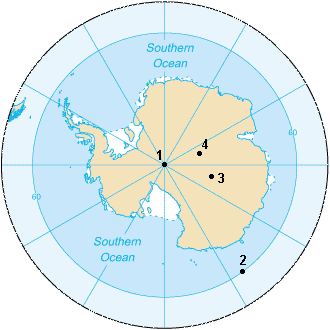|
Giri Raj Singh Sirohi
Giri Raj Singh Sirohi was an Indian plant physiologist who was the first Indian to set foot on the south pole of Antarctica. Career He carried out research in Antarctica in 1960 for around 100 days. The objective of the experiments was to collect data on the Biological Clock at the South Pole, since it represented a place where the rotational activity of the Earth could be negated. The plant material (soybeans, etc.) and animal material (hamsters, etc.) were studied at the South Pole. Project work took almost 12 months, out of which 4 months were spent at the South Pole in Antarctica. He worked as Head & Professor of Plant Physiology Division, Indian Agricultural Research Institute, Delhi, India. He also co-authored a reference book on plant-physiology. Honours Sirohi received the lifetime award from the Indian Society for Plant Physiology in 2003. To honour his breakthrough contribution to the Science of Plant Physiology, the Government of United States named a place ... [...More Info...] [...Related Items...] OR: [Wikipedia] [Google] [Baidu] |
Plant Physiology
Plant physiology is a subdiscipline of botany concerned with the functioning, or physiology, of plants. Plant physiologists study fundamental processes of plants, such as photosynthesis, respiration, plant nutrition, plant hormone functions, tropisms, nastic movements, photoperiodism, photomorphogenesis, circadian rhythms, environmental stress physiology, seed germination, dormancy and stomata function and transpiration. Plant physiology interacts with the fields of plant morphology (structure of plants), plant ecology (interactions with the environment), phytochemistry (biochemistry of plants), cell biology, genetics, biophysics and molecular biology. Aims The field of plant physiology includes the study of all the internal activities of plants—those chemical and physical processes associated with life as they occur in plants. This includes study at many levels of scale of size and time. At the smallest scale are molecular interactions of photosynthesis and internal ... [...More Info...] [...Related Items...] OR: [Wikipedia] [Google] [Baidu] |
Antarctica
Antarctica () is Earth's southernmost and least-populated continent. Situated almost entirely south of the Antarctic Circle and surrounded by the Southern Ocean (also known as the Antarctic Ocean), it contains the geographic South Pole. Antarctica is the fifth-largest continent, being about 40% larger than Europe, and has an area of . Most of Antarctica is covered by the Antarctic ice sheet, with an average thickness of . Antarctica is, on average, the coldest, driest, and windiest of the continents, and it has the highest average elevation. It is mainly a polar desert, with annual Climate of Antarctica#Precipitation, precipitation of over along the coast and far less inland. About 70% of the world's freshwater reserves are frozen in Antarctica, which, if melted, would raise global sea levels by almost . Antarctica holds the record for the Lowest temperature recorded on Earth, lowest measured temperature on Earth, . The coastal regions can reach temperatures over in the ... [...More Info...] [...Related Items...] OR: [Wikipedia] [Google] [Baidu] |
Chronobiology
Chronobiology is a field of biology that examines timing processes, including periodic (cyclic) phenomena in living organisms, such as their adaptation to solar- and lunar-related rhythms. These cycles are known as biological rhythms. Chronobiology comes from the ancient Greek χρόνος (''chrónos'', meaning "time"), and biology, which pertains to the study, or science, of life. The related terms ''chronomics'' and ''chronome'' have been used in some cases to describe either the molecular mechanisms involved in chronobiological phenomena or the more quantitative aspects of chronobiology, particularly where comparison of cycles between organisms is required. Chronobiological studies include but are not limited to comparative anatomy, physiology, genetics, molecular biology and behavior of organisms related to their biological rhythms. Other aspects include epigenetics, development, reproduction, ecology and evolution. The subject Chronobiology studies variations of t ... [...More Info...] [...Related Items...] OR: [Wikipedia] [Google] [Baidu] |
South Pole
The South Pole, also known as the Geographic South Pole or Terrestrial South Pole, is the point in the Southern Hemisphere where the Earth's rotation, Earth's axis of rotation meets its surface. It is called the True South Pole to distinguish from the south magnetic pole. The South Pole is by definition the southernmost point on the Earth, lying antipode (geography), antipodally to the North Pole. It defines geodetic latitude 90° South, as well as the direction of true south. At the South Pole all directions point North; all lines of longitude converge there, so its longitude can be defined as any degree value. No time zone has been assigned to the South Pole, so any time can be used as the local time. Along tight latitude circles, clockwise is east and counterclockwise is west. The South Pole is at the center of the Southern Hemisphere. Situated on the continent of Antarctica, it is the site of the United States Amundsen–Scott South Pole Station, which was established in 19 ... [...More Info...] [...Related Items...] OR: [Wikipedia] [Google] [Baidu] |
Earth
Earth is the third planet from the Sun and the only astronomical object known to Planetary habitability, harbor life. This is enabled by Earth being an ocean world, the only one in the Solar System sustaining liquid surface water. Almost all of Earth's water is contained in its global ocean, covering Water distribution on Earth, 70.8% of Earth's crust. The remaining 29.2% of Earth's crust is land, most of which is located in the form of continental landmasses within Earth's land hemisphere. Most of Earth's land is at least somewhat humid and covered by vegetation, while large Ice sheet, sheets of ice at Polar regions of Earth, Earth's polar polar desert, deserts retain more water than Earth's groundwater, lakes, rivers, and Water vapor#In Earth's atmosphere, atmospheric water combined. Earth's crust consists of slowly moving tectonic plates, which interact to produce mountain ranges, volcanoes, and earthquakes. Earth's outer core, Earth has a liquid outer core that generates a ... [...More Info...] [...Related Items...] OR: [Wikipedia] [Google] [Baidu] |
Soybean
The soybean, soy bean, or soya bean (''Glycine max'') is a species of legume native to East Asia, widely grown for its edible bean. Soy is a staple crop, the world's most grown legume, and an important animal feed. Soy is a key source of food, useful both for its protein and oil content. Soybean oil is widely used in cooking, as well as in industry. Traditional unfermented food uses of soybeans include edamame, as well as soy milk, from which tofu and tofu skin are made. Fermented soy foods include soy sauce, fermented bean paste, nattō, and tempeh. Fat-free (defatted) soybean meal is a significant and cheap source of protein for animal feeds and many packaged meals. For example, soybean products, such as textured vegetable protein (TVP), are ingredients in many meat and dairy substitutes. Soy based foods are traditionally associated with East Asian cuisines, and still constitute a major part of East Asian diets, but processed soy products are increasingly used ... [...More Info...] [...Related Items...] OR: [Wikipedia] [Google] [Baidu] |
Hamster
Hamsters are rodents (order Rodentia) belonging to the subfamily Cricetinae, which contains 19 species classified in seven genera. They have become established as popular small pets. The best-known species of hamster is the golden or Syrian hamster (''Mesocricetus auratus''), which is the type most commonly kept as a pet. Other hamster species commonly kept as pets are the three species of dwarf hamster, Campbell's dwarf hamster (''Phodopus campbelli''), the winter white dwarf hamster (''Phodopus sungorus'') and the Roborovski hamster (''Phodopus roborovskii''), and the less common Chinese hamster (''Cricetulus griseus''). Hamsters feed primarily on seeds, fruits, vegetation, and occasionally burrowing insects. In the wild, they are crepuscular: they forage during the twilight hours. In captivity, however, they are known to live a conventionally nocturnal lifestyle, waking around sundown to feed and exercise. Physically, they are stout-bodied with distinguishing features ... [...More Info...] [...Related Items...] OR: [Wikipedia] [Google] [Baidu] |
Indian Agricultural Research Institute
The Indian Agricultural Research Institute (IARI), commonly known as the Pusa Institute, is India's national institute for agricultural research, education and extension. The name Pusa Institute is derived from the fact that the institute was originally located in Pusa, Bihar as the Imperial Institute of Agricultural Research in 1911. It was then renamed as the Imperial Agricultural Research Institute in 1919 and following a major earthquake in Pusa in 1934, it was relocated to Delhi in 1936. The current institute in Delhi is financed and administered by the Indian Council of Agricultural Research (ICAR). The IARI was responsible for the research leading to the " Green Revolution in India" of the 1970s. IARI ranked First among Agriculture and Allied Universities in the National Institutional Ranking Framework NIRF (India Rankings 2024). History The institute was established in 1905 at Pusa, Bihar, with financial assistance of Henry Phipps, Jr., an American philanthropi ... [...More Info...] [...Related Items...] OR: [Wikipedia] [Google] [Baidu] |
Science
Science is a systematic discipline that builds and organises knowledge in the form of testable hypotheses and predictions about the universe. Modern science is typically divided into twoor threemajor branches: the natural sciences, which study the physical world, and the social sciences, which study individuals and societies. While referred to as the formal sciences, the study of logic, mathematics, and theoretical computer science are typically regarded as separate because they rely on deductive reasoning instead of the scientific method as their main methodology. Meanwhile, applied sciences are disciplines that use scientific knowledge for practical purposes, such as engineering and medicine. The history of science spans the majority of the historical record, with the earliest identifiable predecessors to modern science dating to the Bronze Age in Ancient Egypt, Egypt and Mesopotamia (). Their contributions to mathematics, astronomy, and medicine entered and shaped the Gree ... [...More Info...] [...Related Items...] OR: [Wikipedia] [Google] [Baidu] |
Plant Physiology
Plant physiology is a subdiscipline of botany concerned with the functioning, or physiology, of plants. Plant physiologists study fundamental processes of plants, such as photosynthesis, respiration, plant nutrition, plant hormone functions, tropisms, nastic movements, photoperiodism, photomorphogenesis, circadian rhythms, environmental stress physiology, seed germination, dormancy and stomata function and transpiration. Plant physiology interacts with the fields of plant morphology (structure of plants), plant ecology (interactions with the environment), phytochemistry (biochemistry of plants), cell biology, genetics, biophysics and molecular biology. Aims The field of plant physiology includes the study of all the internal activities of plants—those chemical and physical processes associated with life as they occur in plants. This includes study at many levels of scale of size and time. At the smallest scale are molecular interactions of photosynthesis and internal ... [...More Info...] [...Related Items...] OR: [Wikipedia] [Google] [Baidu] |
Federal Government Of The United States
The Federal Government of the United States of America (U.S. federal government or U.S. government) is the Federation#Federal governments, national government of the United States. The U.S. federal government is composed of three distinct branches: United States Congress, legislative, President of the United States, executive, and Federal judiciary of the United States, judicial. Powers of these three branches are defined and vested by the Constitution of the United States, U.S. Constitution, which has been in continuous effect since May 4, 1789. The powers and duties of these branches are further defined by Act of Congress, Acts of Congress, including the creation of United States federal executive departments, executive departments and courts subordinate to the Supreme Court of the United States, U.S. Supreme Court. In the Federalism in the United States, federal division of power, the federal government shares sovereignty with each of the 50 states in their respective t ... [...More Info...] [...Related Items...] OR: [Wikipedia] [Google] [Baidu] |





